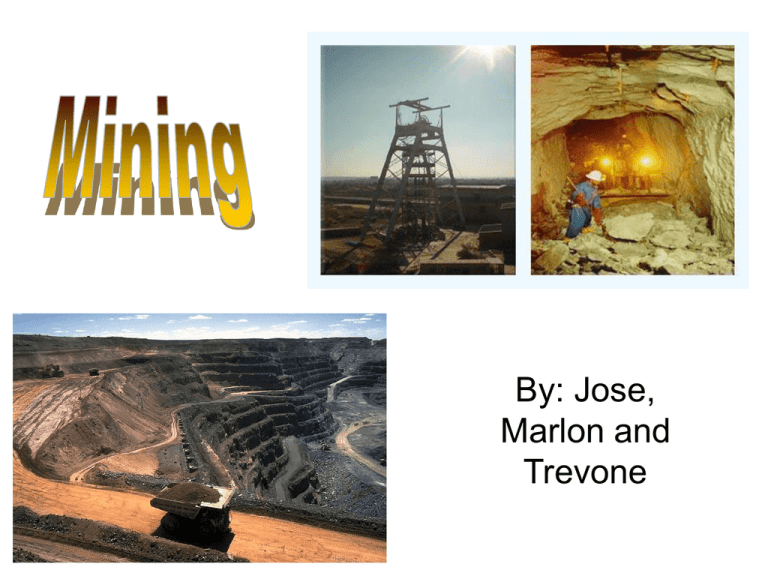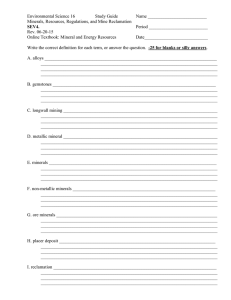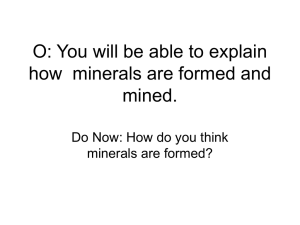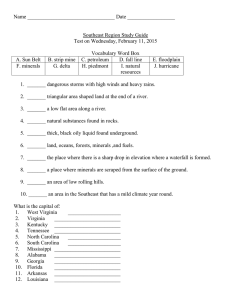By: Jose, Marlon and Trevone
advertisement

By: Jose, Marlon and Trevone Mining is important for many reasons: - Canada is third in the world for mineral production. - Canada doesn’t have a use for all its minerals so it sells about 80% to other countries. - in 2001 Canada’s coal, metallic and non-metallic (industrial) minerals were worth over 24 billion. - Canada’s vast amount of resources play a vital part in our war efforts. - the government also greatly encourages mining companies to find new ways to mine because of how much mining supports Canada’s economy. - Canada’s mineral reserves are decreasing day by day. - the Canadian government is trying to find new mining sites to remain at a steady flow of minerals. - finding new, large deposits is hard because minerals are found in few and specific places around the world. - mining is also an expensive process with includes locating rich deposits, and figuring out the type of rock located in the area. There are 3 types of mining: Underground mining Strip Mining Open pit mining 2 Underground mining is a great way to mine for minerals deep in the ground. 3 What they do: -miners take the cage down to the work area. 1 -holes are drilled then filled with explosives. 1. The cage (elevator). -the blasted rock is taken and sent down a large hole to the crusher. 3. Ventilation pipe. -the crushed rock is placed into a skip with is then hoisted up to the head frame. 4 2. Head frame. 4. Work area. 5. Rock crusher. 6. Skip. 5 Open Pit mining is used to mine for minerals close to the surface, but they can be expanded to mine deeper if needed. 1. Trees, rocks and earth is removed. 2. Explosives are placed 10-15m deep blasting huge holes in the ground. 3. Huge shovels pack 90 to 250 tonnes of ore into trucks. 4. Ore then waits in a storage site near the mill, after it is transferred to a factor to be manufactured. This type of mining is used to mine oilsands, coal and other minerals that are located close to the surface. There are four steps in strip mining: 1. Overburden (trees, earth rock, etc.) are removed. 2. Explosives may be needed to remove some mineral deposits. 3. The material is loaded into trucks by shovel or dragline. 4. The material is then shipped off to a processing mill. There are 3 types of minerals: Fossil Fuels Metallic Minerals Industrial Minerals - when refined they become materials known are metals. - can be valued for rareness and beauty. Example: gold and silver. - iron is used for its strength. - nickel can be combined with iron to make stainless steel. - gold and silver is used to make jewelry. - minerals that can’t be categorized as metallic minerals or fossil fuels. - still important but sometimes not acknowledged as much. - sand makes glass and gravel makes concrete. - potash makes fertilizers. - diamonds make jewelry and cutting tools. - release energy when burned. - fossil fuels are used for transportation and heating. - for 200 years they have provided energy to society. - in the 1800s coal was an important fuel - coal was replaced by oil and gas in the last century. - two steps: milling and smelting. - milling is the process that separates the minerals from the ore. - what is left of the rocks and minerals after this process is called concentrate, but it can still contain 70% of waste rock. - what was separated from the minerals is called tailings with are very toxic and must be dealt with carefully. - the concentrated material is sent to a smelter where it is melted in a furnace. - the newly melted minerals are poured into a mould, cooled the shipped off to the costumers





